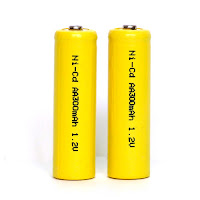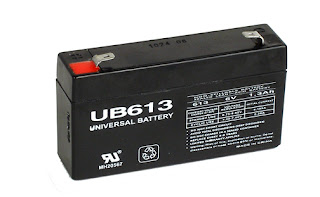Are you Curious to Know that How Rechargeable Batteries accept and store new energy?
Primary cell batteries, when they are discharged they are discarded whereas rechargeable secondary
cell batteries can be supplied with direct current and recharged to almost original levels. Secondary
cells have the ability to restore electrical energy as, unlike primary cells. Because of their electrochemical reactions are electrically reversible, so then can recharge only when a direct current voltage that is higher than the battery’s original voltage is applied in the opposite direction to its discharge direction, this makes the electrons to move back through the charging circuit between
battery’s electrodes and chemical innards.
Lead-acids are the most popular chemical composition form of rechargeable
batteries, in which the battery’s plates, i.e the positive electrode is at the top of the battery, is coated with lead dioxide and the electrolyte. Moreover, the liquid innards of the battery
containing free ions which are carrying current consists of sulphuric acid. This technique makes up a gram of positive active material in a lead-acid in the battery which can deliver up to 100 ampere-hours of energy during its life and able to holds new charges very easily as well. It's fact that lead is cheaper than rival rechargeable battery chemicals such as lithium, cadmium and silver.
There are mainly five types of Rechargeable Batteries which are described below :
- Nickel Cadmium (NiCd)
It's the first rechargeable battery available in low price and they are available in cylinder sizes of AA, AAA, C, D and 9V. They have an advantage of performing well in cold temperature and also redundant with over charging. NiCD batteries are also available in two types which are vented cells and hermetically sealed cells. Vented cells need proper configuration whereas hermetically sealed cells didn't require such things. Such kind of batteries are used in devices like cameras, scanners, cordless phones, radios etc.
- Nickel Metal Hydride (NiMH)
NiMH batteries have many advantages over NiCd batteries. NiMH batteries are much easier to dispose of, so are thought to be more environmentally friendly, although it is important that they should still be recycled correctly. NiCd battery are using metal hydride used instead of cadmium which is used in NiCd batteries. This type of battery is also available in different standard cylinderic sizes. These batteries have 2 to 3 times more capacity than the older NiCd batteries. These are not affected by the "Memory Effect" problem as in NiCd batteries. NiMH is also a form of cost saving battery for low level devices.
- Lithium-ion (Li-ion)
There are the most popular batteries these days because of their high energy density and these batteries are also compatible with many electronic devices. Li-on batteries have good charge retention and can be charged upto thousand times. These batteries are expensive than the previous two types of batteries. Li-on batteries are only available in rectangular and cylinderical shapes. There's no issue of Memory Effect in this battery also and they can be charged even if they are not fully discharged. You have seen Lithium-ion batteries used in cell phones and other mobile computing devices. They are not good in high tempature and can be blown/explode in such condition.
- Sealed Lead Acid - SLA
These are the oldest form of Rechargeable battery. These batteries must be recycled after the life cycle completion because the material used inside is very dangerous(potentially toxic chemicals). The recycling rate of such batteries is very high. These batteries are very reliable and cheap. SLA batteries are commonly used in Uninterrupted Power Supplies, alarms and lighting emergency backup systems. They are commonly used in 6 volts and 12 volts range.
- Nickel Metal Hydride (NiMH)
NiMH batteries have many advantages over NiCd batteries. NiMH batteries are much easier to dispose of, so are thought to be more environmentally friendly, although it is important that they should still be recycled correctly. NiCd battery are using metal hydride used instead of cadmium which is used in NiCd batteries. This type of battery is also available in different standard cylinderic sizes. These batteries have 2 to 3 times more capacity than the older NiCd batteries. These are not affected by the "Memory Effect" problem as in NiCd batteries. NiMH is also a form of cost saving battery for low level devices.
- Lithium-ion (Li-ion)
There are the most popular batteries these days because of their high energy density and these batteries are also compatible with many electronic devices. Li-on batteries have good charge retention and can be charged upto thousand times. These batteries are expensive than the previous two types of batteries. Li-on batteries are only available in rectangular and cylinderical shapes. There's no issue of Memory Effect in this battery also and they can be charged even if they are not fully discharged. You have seen Lithium-ion batteries used in cell phones and other mobile computing devices. They are not good in high tempature and can be blown/explode in such condition.
- Sealed Lead Acid - SLA
These are the oldest form of Rechargeable battery. These batteries must be recycled after the life cycle completion because the material used inside is very dangerous(potentially toxic chemicals). The recycling rate of such batteries is very high. These batteries are very reliable and cheap. SLA batteries are commonly used in Uninterrupted Power Supplies, alarms and lighting emergency backup systems. They are commonly used in 6 volts and 12 volts range.
http://www.amazon.com/gp/search/ref=as_li_qf_sp_sr_il_tl?ie=UTF8&camp=1789&creative=9325&index=aps&keywords=rechargeable%20batteries&linkCode=as2&tag=vixiworl-20





Post a Comment